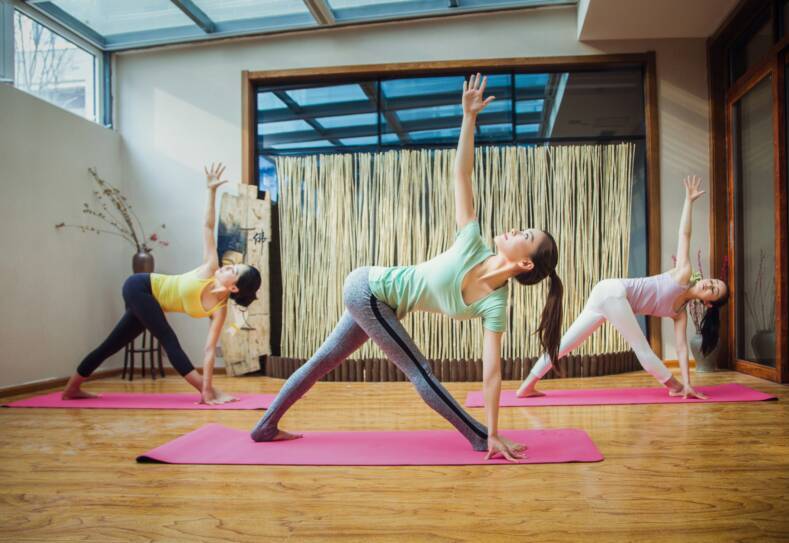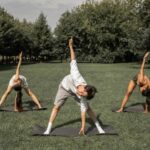Incorporating daily stretching into one’s routine can yield numerous health benefits. Stretching enhances flexibility, which is a crucial component of overall fitness. Flexible muscles can improve a person’s performance in physical activities, decrease the risk of injuries by helping joints move through their full range of motion and enable muscles to work most effectively. As flexibility often diminishes with age, maintaining it through daily stretching can also contribute to better posture, balance, and coordination.
As an adjunct to other forms of exercise, stretching has been shown to improve blood flow to the muscles. This increased circulation can help with muscle recovery and decrease post-exercise soreness. Regular stretching routines are also associated with reduced tension in muscles, which can alleviate pain and reduce the discomfort associated with chronic conditions such as lower back pain.
Beyond the physical benefits, stretching daily can have a positive impact on mental health. It presents an opportunity for individuals to focus on their body’s movements and take a break from the day’s stresses, potentially contributing to a decreased level of stress and a more relaxed state of mind. This mindful approach to exercise can have a holistic effect on well-being, promoting not only physical health but also psychological resilience.
The Science of Stretching
Stretching is integral to maintaining flexibility and a full range of motion in the joints. Through scientific understanding, the act of stretching is shown to enhance muscular coordination and can contribute to overall physical wellbeing.
Understanding Flexibility and Range of Motion
Flexibility refers to the ability of a muscle to lengthen, allowing for a greater range of motion around a joint. This capability depends largely on the elasticity of the muscles and connective tissues, such as ligaments and tendons. Good flexibility facilitates daily activities by improving joint mobility and reducing the likelihood of injury.
- Ligaments: Tough, fibrous connective tissues that connect bones to other bones.
- Tendons: Flexible, yet inelastic cords of strong fibrous collagen tissue which attach muscles to bones.
Increasing flexibility through regular stretching can lead to improved balance, fewer injuries, and better posture.
Types of Stretching: Dynamic and Static
Two major classifications of stretching are dynamic and static, both benefiting the body in different ways and often incorporated into physical activities and exercise routines.
- Dynamic Stretching involves moving parts of the body smoothly through their complete range of motion. This type of stretching is generally performed before activity to warm up the muscles.
| Example of Dynamic Stretching | Description |
|---|---|
| Arm Swings | Swinging arms in controlled motion to loosen shoulder muscles. |
| Leg Swings | Moving legs back and forth to warm up the hip joints. |
Dynamic stretches prepare the muscles for movement and activate the nervous system.
- Static Stretching is characterized by holding a stretch without movement, usually at the end of an exercise session to enhance muscular relaxation.
| Example of Static Stretching | Description |
|---|---|
| Toe Touch | Standing, bend at the waist and hold the reach to the toes. |
| Quadriceps Stretch | Standing, pull one foot toward the buttocks and hold. |
Holding static stretches may increase flexibility and joint range of motion. However, extensive static stretching before engaging in high-intensity activities might temporarily decrease muscle strength.
Health Benefits of Regular Stretching
Regular stretching plays an essential role in improving overall health by enhancing physical fitness and aiding in the prevention and management of pain. It is a cornerstone of physical activity that benefits muscle strength, joint health, and can contribute to stress reduction.
Enhanced Physical Fitness
Muscle Strength & Flexibility
– Regular stretching helps maintain muscle strength, ensuring muscles can exert their full function.
– It also increases flexibility, which is crucial for maintaining a range of motion in the joints.
Joint Health & Mobility
– Sufficiently stretched muscles keep joints healthy.
– Flexibility gained from regular stretching can improve overall mobility, lessening the likelihood of movement-related injuries.
Prevention and Management of Pain
Back Pain
– By stretching regularly, individuals can alleviate and prevent back pain, as tension in the muscles is released.
– Strengthening and elongating the spine through stretching can reduce the strain that contributes to back discomfort.
Stress-Related Tension
– Stress often manifests physically as tension in the muscles.
– Implementing a regular stretching routine can help relax tense muscles and provide a mental break, which may help to reduce overall stress levels.
Stretching Techniques and Best Practices
Engaging in regular stretching is essential for maintaining flexibility and preventing muscle tightness. Understanding effective warming up methods and stretching techniques is pivotal in achieving the best results from one’s daily routine.
Proper Ways to Warm up Before Exercising
Prior to stretching, one should warm up adequately to prepare the muscles for physical activity. Warming up increases muscle temperature and circulation, which reduces the risk of injury. A dynamic warm-up, incorporating movements like leg swings or arm circles, gently and gradually brings up the heart rate and loosens joints.
- Dynamic Stretch Example:
- Leg Swings: Stand on one leg and swing the other leg forward and back, increasing the height with each swing.
Techniques to Maximize Effectiveness
For stretching to be as effective as possible, specific techniques and best practices must be consistently applied. Holding each stretch for about 30 seconds is recommended to sufficiently lengthen the muscle fibers without causing strain. A physical therapist can offer personalized guidance to ensure proper form.
- Do:
- Keep steady breaths to help decrease tension.
- Apply gentle pressure to deepen the stretch without pain.
- Don’t:
- Bounce during stretches as this can cause muscle tear.
- Overstretch to the point of pain; discomfort is normal, but pain is a warning sign.
Methodically incorporating these practices into a daily routine helps enhance flexibility, promotes better posture, and can lead to improved performance in physical activities.
Role of Stretching in Injury Prevention
Stretching is a vital component of injury prevention, which can enhance muscle elasticity and joint health. It is widely recognized as an essential part of health regimens and sports medicine practices.
Reducing the Risks of Muscle Strains and Joint Injuries
Muscle Strains: Regular stretching can significantly decrease the risk of muscle strains. Stretches increase the muscles’ length and flexibility, reducing tension and the potential for injury while performing daily activities or exercising.
- Prevention: Stretching before and after physical activity warms up the muscles, preparing them for the stress of movement and helping to prevent tears.
- Recovery: In the case of existing muscle soreness, gentle stretching can aid in recovery by promoting blood flow and nutrient distribution to the affected muscles.
Joint Injuries: Stretching also maintains joint health. By improving the range of motion, one mitigates the stress on joints that can occur during physical tasks.
- Increased Mobility: Proper stretching techniques can help preserve or improve the range of motion of joints, contributing to better overall mobility.
- Reduction in Pain: Frequent stretching may lead to a decreased experience of pain from joint stress or muscle tightness.
Stretching in Sports Medicine
In the field of sports medicine, doctors stress the importance of incorporating stretching into an athlete’s routine for injury prevention.
- Personalization: Sports medicine professionals often design stretch routines that are tailored to the specific needs of each athlete, focusing on areas of potential vulnerability.
- Education: Athletes are educated on proper stretching techniques to ensure effectiveness and prevent adverse effects, like potential overstretching.
Expert Guidance: A sports medicine doctor can provide athletes with insight into the types of stretches that are most beneficial for certain sports, reducing injury occurrence and enhancing performance.
Stretching for Different Muscle Groups
Proper stretching can support the flexibility and health of various muscle groups, contributing to overall mobility and injury prevention. Focused stretching routines target specific areas of the body, promoting balanced muscular function and joint stability.
Upper Body: Neck, Shoulders, and Chest
Neck: Gently rotating the head in a controlled manner stretches the neck muscles, enhancing their range of motion. Care should be taken to avoid overextension.
Shoulders: Specific stretches target the deltoids and rotator cuffs. Exercises such as arm circles and shoulder stretches help maintain shoulder flexibility and stability.
Chest: Chest stretches can relieve tension from prolonged sitting or standing. They often involve extending the arms or using a doorway to stretch the pectoral muscles.
Lower Body: Hips, Hamstrings, and Calves
Hips: Hip stretches focus on the hip flexors, abductors, and adductors. Movements such as lunges and hip rotations aid in keeping the hip joint flexible.
Hamstrings: Tight hamstrings can lead to lower back discomfort. Leg stretches where one reaches forward to touch the toes are effective for elongating these muscles.
Calves: To prevent tightness, calf stretching is important, especially for athletes. Simple exercises such as heel drops can maintain calf muscle elasticity and support ankle joint health.
Stretching Across the Lifespan
Incorporating stretching into one’s daily routine can offer various age-specific benefits, enhancing flexibility, promoting muscular health, and potentially reducing the risk of injury.
Stretching for Children and Adolescents
Children and adolescents experience rapid growth and physical changes, which can sometimes lead to muscle tightness. Regular stretching can aid in managing this tightness, thus contributing to better mobility and potentially preventing injuries. It is crucial that stretches are age-appropriate and consider the child’s growth stage to avoid joint stress.
- Benefits for Children and Adolescents:
- Improved range of motion
- Better posture and balance
- Enhanced athletic performance
Stretching for Older Adults
As individuals age, they often face increased joint stiffness and muscle tightness, which can impact daily activities and contribute to conditions like arthritis. Stretching routines for older adults should focus on maintaining flexibility and managing discomfort.
- Considerations for Older Adults:
- Gentle stretching techniques
- Focus on major muscle groups to maintain functionality
- Regular stretching to manage joint stiffness related to arthritis
Regular stretching for older adults can also help alleviate tension headaches and may improve sleep quality by reducing overall tension in the body. It’s important for older adults to stretch within their comfort level and to avoid pushing painful joints too far.
Incorporating Stretching into Your Daily Routine
Incorporating stretching into one’s daily routine enhances mobility and posture, which can contribute to both better athletic performance and ease in performing everyday activities.
Simple Stretches for Everyday Activity
Individuals can integrate stretching seamlessly into their lives by starting with simple stretches that enhance movement for daily tasks. For example:
- Neck and Shoulders: Tilt the head from side to side, and roll shoulders forward and backward, to release tension.
- Hamstrings: Place one foot in front of the other and lean forward from the hips, keeping the back straight, to stretch the back of the thigh.
- Lower Back: While seated, lean forward with a straight back, reaching toward the toes to alleviate lower back stiffness.
These stretches should be held for 15-30 seconds and repeated at least once, ensuring that all major muscle groups are addressed to maintain functional mobility.
Designing a Personalized Stretching Program
Creating a personalized stretching program requires considering individual fitness levels, daily activity patterns, and any unique wellness goals or needs a person might have. It should include:
- Dynamic stretches: Such as leg swings or arm circles, as part of a warm-up to prepare the body for movement.
- Static stretches: Post-exercise to improve flexibility, involving holding a stretch for a period of time.
A balanced program will alternate between different types of stretches, addressing all muscle groups. It may look something like this:
| Muscle Group | Dynamic Stretch | Static Stretch |
|---|---|---|
| Legs | Leg swings | Forward fold |
| Arms | Arm circles | Tricep stretch |
| Torso | Torso twists | Side bend |
By tailoring the stretching routine to personal needs, individuals can make it an integral and efficient part of daily life, enhancing their overall exercise prescription.
Understanding the Risks of Overstretching
While stretching has numerous benefits, including improved flexibility and range of motion, it is critical to approach this activity with caution. Overstretching can lead to injuries such as strains and sprains, which can sideline an individual from physical activities.
Recognizing Your Body’s Limits
When someone engages in a stretching routine, they should be mindful of their body’s natural limits. The goal is to feel a slight stretch in the muscles, not to achieve an unrealistically far range of motion. Risks of pushing past these limits include muscle damage and joint pain. The discomfort felt should never graduate to pain, as this is a clear indication that the tissues are being overstressed.
Key Signs of Overstretching:
- Sharp or severe pain
- Joint instability
- Decreased strength or ability to move the affected area
How to Respond to Discomfort
In the event of experiencing discomfort beyond mild stretching sensations, one should immediately cease the activity and address the discomfort. If the discomfort persists, seeking advice from a qualified clinician is crucial. For both a strain (an overstretch or tear of a muscle or tendon) and a sprain (an overstretch or tear of a ligament), the recommended initial response includes:
Immediate Actions:
- Rest: Avoid using the affected area to prevent further injury.
- Ice: Apply ice to reduce swelling and numb the discomfort.
- Compression: Use a compression bandage to minimize swelling and provide support.
- Elevation: Keep the injured area raised above the heart level to decrease swelling.
By understanding one’s body’s limits and knowing how to respond to discomfort appropriately, the risks of overstretching can be minimized, preserving muscle health and overall physical well-being.








